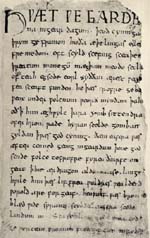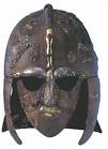
(The first leaf of the Beowulf Manuscript--Tolkien had memorized the poem in Old English)
Beowulf, Maldon and JRR Tolkien
Bibliography:
JRR Tolkien. Beowulf: The Monsters and the Critics. Proceedings of the British Academy, 1936.
JRR Tolkien. (Humphrey Carpenter, ed.). The Letters of JRR Tolkien. Boston: Houghton Mifflin, 1981.
JRR Tolkien. The Tolkien Reader. New York: Ballantine, 1966.
Beowulf. Copies of the poem are on line, and criticism of the poem may be found on my BRITISH LITERATURE WEB SITE
On June 27, 1925 Tolkien submitted a letter to the University of Oxford applying for the Professorship of Anglo-Saxon Studies, (Letters, p. 12-13) in which he outlined his "enthusiasm for Anglo-Saxon studies...[as] naturally attractive" to him. At age 33, he received the appointment. Tolkien later referred to the Essay as "the contact of the heroic with the fairy-story." (Letters, p. 350), as well as his love of linguistics and his work on the OED.
Tolkien argues that myths are, "Stories told about man’s relationship with nature; localized in time and place.." as we will discuss when analyzing the Essay on Fairy Tales, and his approach to BEOWULF revolutionized our understanding of the poem.
STUDY GUIDE TO THE ESSAY
I. REACTION TO A SCIENTIFIC READ…
A. Frankenstein notwithstanding, romantics tend to distrust science's tendency to dissect, for in so doing we kill that which we should want to preserve. Tolkien strongly objected to seeing BEOWULF as a archeologically valuable text once the poetic "irrelevancies" were dismissed.
B. In articulating his view, Tolkien used the metaphor of the tower. What did he mean? What happens when the tower is destroyed? Note how romantic period philosophy is at the heart of what he believes.
II. Explain the following as misreads of the poem according to JRRT:
A. Why is the poem considered "half-baked" by misinformed critics?
B. What accounts for the poem being "confused and muddled" by critics, and what according to
Tolkien is the misread?
C. How does Tolkien view the "Christian / Pagan elements" in the poem that appear to make it a victim of sloppy editorial work? Recall Hrothgar's "anti-pride" speech to Beowulf after the second fight, as compared to what Beowulf says after the death of Aeschere.
III. WHAT DO THE MONSTERS REALLY REPRESENT?--WHY DOES TOLKIEN SEE THEM AS THE 'CENTER' OF THE POEM?

(The first leaf of the Beowulf Manuscript--Tolkien had memorized the poem in Old English)
A. The "potent creation" of man's imagination
B. What vice is present? Note the "G" alliteration pattern in the poem as the clue
C. Don't forget the ending of THE HOBBIT.
IV. BEOWULF--IS THE UNDEFEATED WILL CONFRONTING THE ANGLO-SAXON TRAGEDY OF SIMPLY LIVING…
A. What role does the will have here? Does this contradict what we noted when looking at Tolkien's romantic period ideas?
B. Another Anglo Saxon poem, called THE BATTLE OF MALDON, has a line that for Tolkien summed the meaning of Anglo - Saxon culture:
C. The poem is a fragment., with the beginning and ending lost. In the late 10th century, Danish raids on the English coast were frequent. This poem describes how the Saxons under Bryhtnoth met the Danes under Anlaf, the Viking cyn. The Vikings demanded tribute, and the English quickly refused so battle was joined. The English were winning because the Danes were pinned down on a narrow strip of land linking an island to the battlefield . Seeing this, the Danes asked if they could be allowed to cross it unattacked so the fight would be fair :
When the hated strangers saw and understood
what bitter bridge warders were brought against them there,
they began to plead with craft , craving leave
to fare over the ford and lead across their footman.
The following is Bryhtnoth’s response:
Then the Eorl was overswayed by his heart’s arrogance
to allow overmuch land to that loath nation:
the men stood silent and Brighthelm’s son
called out over the cold water.
The ground is cleared for you: come quickly to us,
gather to battle . God alone knows
who shall carry the wielding of this waste ground.

As soon as the Danes cross, the battle continues, and the English are slaughtered. In the battle, Bryhtnoth is killed. The fragment concludes with Byrhtwold’s battle cry to the losing English. This has been called by Tolkien the finest example of the Anglo-Saxon comitatus code.
Courage shall grow keener, clearer the will,
the heart fiercer,as our force faileth
Here our lord lies, leveled in the dust,
The man all marred:: he shall mourn to the end
who thinks to wend off from this war-play now.
Though I am white with winters, I will not away,
For I think to lodge me alongside my dear one,
lay me down by my lord's right hand.
For Tolkien, such embodies the spirit of BEOWULF, so much so that he wrote a sequel, a play called THE HOMECOMING OF BEORHTNOTH, BEORHTHELM'S SON in which a scop's son's perspective contrasts with the veterans of combat:
Torhthelm: Realms here they won and royal kingdoms,
and in olden days this isle conquered.
And now from the North need comes again:
wild blows the wind of war to Britain.
Tidwald: And in the neck we catch it, are nipped as
chill as poor men were then. Let the poets
babble, but perish all pirates. When the poor
are sobbed and lose the land they love and
toiled on, they must die and dung it. No dirge
for them, and their wives and children
work in serfdom...
Torhthelm: ...Heart shall be bolder, harder be
purpose, more proud the spirit as our power
lessens. Mind shall not falter...
His chant is interrupted when the cart they are driving to remove the dead hits a large bump: "Hey what a bump, Tida. My bones are shaken, and my dream shattered."
Tolkien hates the waste of war: the play ends with a voice in the dark...
Direct or Lord in thy sight my path
I shall enter into thy house...
Lord lead me in thy justice
On account of my enemies
Direct my path in thy sight.
(The Tolkien Reader, pp. 6-18)
V. NOTE TOLKIEN'S SUMMARY OF ANGLO-SAXON VALUES...
A. Recall what is meant by the COMITATUS CODE--note the references to 'word hoard' and 'treasure hoard' in BEOWULF.
B.Why are the monsters the center of the poem?
C. Is there a solution offered to the tragedy of man?
D. Finish this: "We have great pagan on the threshold of..."
E. Tolkien sees Beowulf as a "contrasted description of two..."
VII. Why then is the TOWER metaphor so important?